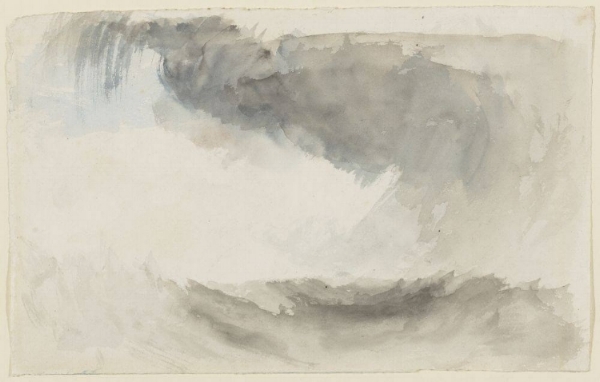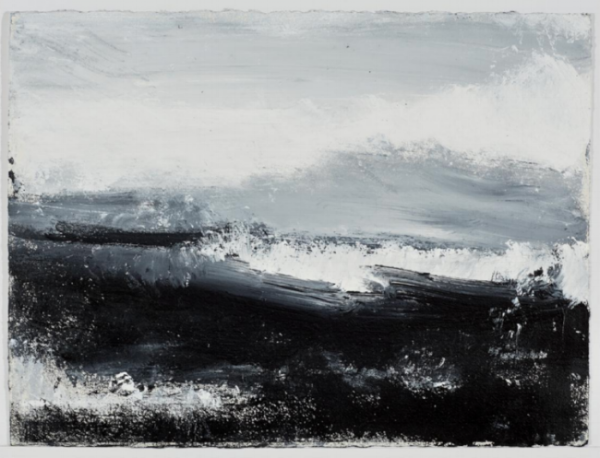John Virtue at Fortnum's X Frank (FXF18) at Fortnum and Mason
Collector Frank Cohen brings the works of John Virtue to Fortnum and Mason, Piccadilly. September is a busy month in London as the Turner Prize opens—cue: cries/groans/outrage—and gallerists and collectors start gossiping in preparation for the Frieze Art Fair in October. But don’t miss out on Virtue’s works on display (and for sale) at the renowned department store opposite the Royal Academy for Fortnum’s X Frank (FXF18).
Virtue probably didn’t ‘schmooze’ enough during the 1980s and 1990s to come to greater public prominence—though, that’s changing. He was too busy painting. Consequently, his reputation doesn’t rest on just a few, select works. Instead, it’s born of thousands upon thousands of sketches and hundreds upon hundreds of paintings. He’s spent the past 50 years walking and painting the landscape in black, shellac and white acrylic. His monochromatic works have presented FXF18’s curator, Robert Upstone, whose fine eye served the Tate Britain for many years, with something of a challenge to present alongside the luxury wares and vendables of the store. Thankfully, the task is mitigated by Fortnum and Mason’s proud history of supporting the arts: its catalogues were sometimes designed by Oliver Messel and Ronald Ferns and its interior boasts murals by John Banting and Kathleen Hale. Moreover, this isn’t the first time Fortnum and Mason have collaborated with Cohen. FXF16 saw over 60 paintings from Cohen’s collection adorn the store. Last year, they focussed exclusively on the works of John Bellany.
John Virtue’s Landscape No. 174 (1990-92) Courtesy of Albion Barn
But 2018 belongs to Virtue. Born in Accrington, Lancashire, Virtue studied under Frank Auerbach at the Slade School of Fine Art in the 1960s when Sir William Coldstream was the Slade Professor. Coldstream’s earlier dalliance with ‘objective abstraction’ had given way to an emphasis on realist figuration. He mentored Auerbach, Euan Uglow, Lucien Freud, Michael Andrews, et al., thus helping to preserve the dignity of figurative art—and in particular, figure painting—during abstraction’s mid-century onslaught.
One might say that for Virtue, it was a case of wrong place, wrong time. His craft was yet imbued with Abstract Expressionism—in particular, that complicated abstraction of Franz Kline. He wasn’t enamoured with the Pop that had succeeded Kline and Jackson Pollock. (He abandoned the ‘distraction’ of colour shortly after graduating the Slade.) He wasn’t really interested in figure painting. Instead, Virtue wanted to interpose Kline and Pollock’s subjectivity of abstraction vis-à-vis the natural landscape. London wasn’t for Virtue. He’d spectacularly return as Associate Artist at the National Gallery in 2003. But for now, not yet. So in 1971, he returned to Lancashire.
Specifically, the village of Green Haworth. He found employment as a postman—apparently, the perfect job for an artist: you wake up early, walk and finish around noon. You’ve then got the afternoon to work on your art. At least, that’s what I’m told. But for Virtue, it was the walking rather than the early finish that mattered. He still takes long walks, always sketching. He once described his sketches to Andrew Graham-Dixon as a ‘visual diary’ of each day, week, month, year, decade. ‘So the walking was like walking through your own life.’ So what’s the art about? ‘It’s about mortality.’ He’s numbered every canvas: No.1, No.2, No.3 and so on… Since then, it’s been a constant retracing of steps, ink and paint around Lancashire, Blakeney Point, Norfolk, and the Exe Estuary, Devon. He keeps working on that ‘visual diary’ then reworks them in paint in the studio.
Virtue is now 71 and this emphasis on ‘mortality’ rather suggests something of ‘Sonnet 12’ by Shakespeare: that ‘violet past prime, And sable curls all silver’d o’er with white; When lofty tress I see barren of leaves,’ and so on. And yes, there is the artist’s transience through pasture and time: Virtue recently spoke at the Courtauld Institute of ‘the stretches of moorland, the weather, the seasons—they all became familiars through this minimalistic repetition of glancing and gazing and moving and drawing.’ He spoke of the ‘ritual’ of walking. You sense, too, that this sense of ‘ritual’ quietly refers to Virtue’s favourite Japanese Calligraphers, Sengai Gibon and Torei Enji. For like Kline, Virtue adores the economical, but surprisingly expressive vagaries of the calligrapher’s brush. He thinks in terms of the ‘weight, gravity, movement’ of the hand across the canvas…
When Virtue returned to London after so many years in Lancashire and Devon, the city was just another landscape. Something to be drawn and redrawn, painted. The National Gallery requires its Associate Artist to engage with the gallery’s pre-1900 collection thus demonstrating the continuing influence of the Old Masters. For Virtue, it was the great landscape painter, J.M.W Turner.
Consider Turner’s watercolour, A Storm at Sea (c., 1831) which was acquired by the Minneapolis Institute of Arts in 2014. Such preliminary sketches are called ‘colour beginnings.’ Virtue rejects colour, of course, but does such ‘beginnings’ afresh in monochrome. His No.46 (2012-13) forgoes the easy translucency of watercolours; consequently, the water’s spray and sky’s light is fought for in white acrylic among the black and shellac.
Virtue strikes me as a journeyman—not only because ‘journeyman’ comes from journée meaning ‘day’ in French (think of that ‘visual diary’ that’s expanded day-by-day)—but because he’s skilled, competent and experienced. Cohen, who made his fortune flogging paint and wallpaper to contractors, has always had a soft spot for those craftsmen and women of substance whose works aren’t mere conceptualism, but properly worked and re-worked paint. He often describes Virtue as ‘underappreciated’ in a world that’s gone ‘Contemporary mad.’
Cohen also praises Virtue as ‘unique, tough and uncompromising in his art.’ (He won the Sunday Mirror painting competition in 1964; the Walter Neurath Prize in 1966; the Arts Council Major Award in 1981; and was joint first in the Tolly Cobbold Exhibition of 1983 before winning Best Visual Artist in the South Bank Awards in 2006.) So it’s true that Virtue has some great admirers: not only Cohen, but Simon Schama and Richard Dorment, who singled out Virtue’s works for praise during the RA Summer Exhibition, 2002. He’s got detractors too. (Don’t the best artists start a conversation, divide opinion?) He doesn’t impress Jonathan Jones, which is, perhaps, the highest praise of all. You’ll have to find out for yourself at Fortnum and Mason’s this September.


